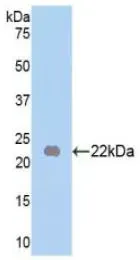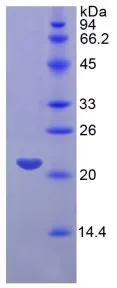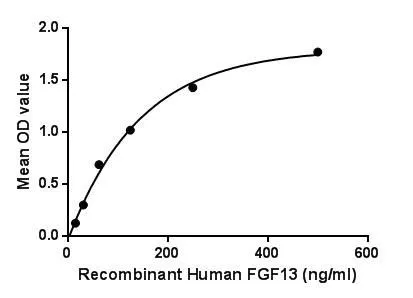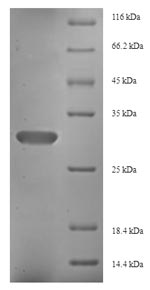
WB analysis of GTX00266-pro Human FGF13 protein.
Human FGF13 protein, His tag
GTX00266-PRO
ApplicationsFunctional Assay
Product group Proteins / Signaling Molecules
Protein IDQ92913
Overview
- SupplierGeneTex
- Product NameHuman FGF13 protein, His tag
- Delivery Days Customer9
- Application Supplier NoteFibroblast growth factor 13 (FGF13) is a member of the fibroblast growth factor (FGF) family. FGF family members possess broad mitogenic and cell survival activities, and are involved in a variety of biological processes, including embryonic development, cell growth, morphogenesis, tissue repair, tumor growth, and invasion. Besides, Prion Protein (PRNP) has been identified as an interactor of FGF13, thus a binding ELISA assay was conducted to detect the interaction of recombinant human FGF13 and recombinant human PRNP. Briefly, FGF13 were diluted serially in PBS, with 0.01% BSA (pH 7.4). Duplicate samples of 100 microl were then transferred to PRNP-coated microtiter wells and incubated for 2h at 37C. Wells were washed with PBST and incubated for 1h with anti-FGF13 pAb, then aspirated and washed 3 times. After incubation with HRP labelled secondary antibody, wells were aspirated and washed 3 times. With the addition of substrate solution, wells were incubated 15-25 minutes at 37C. Finally, add 50 microl stop solution to the wells and read at 450nm immediately. The binding activity of FGF13 and PRNP was in a dose dependent manner.
- ApplicationsFunctional Assay
- CertificationResearch Use Only
- ConjugateUnconjugated
- Protein IDQ92913
- Protein NameFibroblast growth factor 13
- Scientific DescriptionThe protein encoded by this gene is a member of the fibroblast growth factor (FGF) family. FGF family members possess broad mitogenic and cell survival activities, and are involved in a variety of biological processes, including embryonic development, cell growth, morphogenesis, tissue repair, tumor growth, and invasion. This gene is located in a region on chromosome X, which is associated with Borjeson-Forssman-Lehmann syndrome (BFLS), making it a possible candidate gene for familial cases of the BFLS, and for other syndromal and nonspecific forms of X-linked cognitive disability mapping to this region. Alternative splicing of this gene at the 5 end results in several transcript variants encoding different isoforms with different N-termini. [provided by RefSeq, Nov 2008]
- Storage Instruction-20°C or -80°C,2°C to 8°C
- UNSPSC12352202






